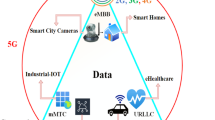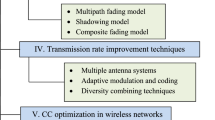Abstract
In this paper, we investigate the performance of a dual-hop fixed-gain amplify-and-forward relay system in the presence of co-channel interference at the destination node. Different fading scenarios for the desired user and interferers’ channels are assumed in this study. We consider the Rician/Nakagami-\(m\), the Rician/Rician, and the Nakagami-\(m\)/Rician fading environments. In our analysis, we derive accurate approximations for the outage probability and symbol error probability (SEP) of the considered scenarios. The generic independent non-identically distributed (i.n.d.) case of interferers’ channels is considered for the Rician/Nakagami-\(m\) scenario; whereas, the independent identically distributed (i.i.d.) case is studied for the Rician/Rician and the Nakagami-\(m\)/Rician environments. Furthermore, to get more insights on the considered systems, high signal-to-noise ratio (SNR) asymptotic analysis of the outage probability and SEP is derived for special cases of the considered fading scenarios. Monte-Carlo simulations and numerical examples are presented in order to validate the analytical and asymptotic results and to illustrate the effect of interference and other system parameters on the system performance. Results show that the different fading models of interferers’ channels have the same diversity order and that the interference degrades the system performance by only reducing the coding gain. Furthermore, findings show that the case where the fading parameter of the desired user first hop channel is better than that of the second hop gives better performance compared to the vise versa case, especially, at low SNR values; whereas, both cases almost behave the same at high SNR values where the performance of the system is dominated by the interference affecting the worst link. Finally, results show the big gap in system performance due to approximating the Rician fading distribution with the Nakagami-\(m\) distribution which is an indication on the inaccuracy of making such approximations in systems like the considered.














Similar content being viewed by others
References
Laneman, J. N., Tse, D. N. C., & Wornell, G. W. (2004). Cooperative diversity in wireless networks: Efficient protocals and outage behavior. IEEE Transactions on Information Theory, 50(12), 3062–3080.
Mheidat, H., & Uysal, M. (2006). Impact of receive diversity on the performance of amplify-and-forward relaying under APS and IPS power constraints. IEEE Communications Letters, 10, 468–470.
Senaratne, D. & Tellambura, C. (June 2009). Unified performance analysis of two hop amplify and forward relaying. In Proceedings IEEE ICC, Dresdn, Germany, pp. 1–5.
da Costa, D. B., Ding, H., & Ge, J. (May 2011). Interference-limited relaying transmissions in dual-hop cooperative networks over Nakagami-\(m\) fading. IEEE Communications Letters, 15(5), 503–505.
Al-Qahtani, F. S., Duong, T. Q., Zhong, C., Qaraqe, K. A., & Alnuweiri, H. (Aug 2011). Performance analysis of dual-hop AF systems with interference in Nakagami-\(m\) fading channels. IEEE Signal Processing Letters, 18(8), 454–457.
Milośević, N., Nikolić, Z. & Dimitrijević, B. (April 2011) Performance analysis of dual hop relay link in Nakagami-\(m\) fading channel with interference at relay. In Proceedings 22nd International conference radioelektronika, pp. 1–4.
Dohler, R., Lefranc, E., & Aghvami, H. (2003). Space-time block codes for virtual antenna arrays. In Proceedings International conference on telecommunication, France, pp. 198–203.
Zhong, C., Jin, S., & Wong, K. (2009). Outage probability of dual-hop relay channels in the presence of interference (pp. 1–5). IEEE VTC Spring.
Al-Qahtani, F., Zhong, C., Qaraqe, K., Alnuweiri, H., & Ratnarajah, T. (Dec 2011). Performance analysis of fixed-gain AF dual-hop relaying systems over Nakagami-m fading channels in the presence of interference. EURASIP Journal on Wireless Communications and Networking.
Hasna, M. & Alouini, M.-S. (Jan 2004). Harmonic mean and end-to-end performance of transmission systems with relays. IEEE Transactions on Communications, 52(1), 130–135.
Xu, W., Zhang, J., & Zhang, P., Outage probability of two-hop fixed-gain relay with interference at the relay and destination. IEEE Communications Letters, to be published.
da Costa, D. B. & Yacoub, M. D. (Sep. 2011). Outage performance of two hop AF relaying systems with co-channel interferers over Nakagami-\(m\) fading. IEEE Communications Letters, 15(9), 980–982.
Chen, S., Zhang, X., Liu, Fa. & Yang, D. (2010). Outage performance of dual-hop relay network with co-channel interference. In Proceedings IEEE VTC Spring, pp. 1–5.
Ikki, S. S., & Aïssa, S. (2010). Performance analysis of dual-hop relaying systems in the presence of co-channel interference. In Proceedings IEEE GLOBECOM, Miami, Florida.
Cvetković, A., Dordević, G., & Stefanović, M. (2011). Performance of interference-limited dual-hop non-regenerative relays over Rayleigh fading channels. IET Communications, 5(2), 135–140.
da Costa, D. & Yacoub, M. (Aug 2011). Dual-hop DF relaying systems with multiple interferers and subject to arbitrary Nakagami-\(m\) fading. Electronics Letttters, pp. 999–1001.
Prasad, R., Kegel, A., & Loog, M. (1992). Cochannel interference probability for picocellular system with multiple Rician faded interferers. Electronics Letters, 28(24), 2225–2226.
Suraweera, H. A., Michalopoulos, D. S., Schober, R., Karagiannidis, G. K. & Nallanathan, A. (June 2011). Fixed gain amplify-and-forward relaying with co-channel interference. In Proceedings IEEE ICC, Kyoto, Japan, pp. 1–6.
Gradshteyn, I. S., & Ryzhik, I. M. (2000). Tables of integrals, series and products (6th ed.). San Diago: Acadamic Press.
Simon, M. K., & Alouini, M.-S. (2005). Digital communication over fading channels (2nd ed.). London: Wiley.
Abramowitz, M., & Stegun, I. A. (1970). Handbook of mathematical functions with formulas, graphs, and mathematical tables (9th ed.). New York, NY: Dover Publications.
Acknowledgments
This work is supported by King Fahd University of Petroleum & Minerals (KFUPM) through project of grant number FT121002. The paper was made possible by JSREP grant # 3-039-2-010 from the Qatar National Research Fund (a member of Qatar Foundation). The statements made herein are solely the responsibility of the authors.
Author information
Authors and Affiliations
Corresponding author
Rights and permissions
About this article
Cite this article
Salhab, A.M., Al-Qahtani, F.S., Zummo, S.A. et al. Performance Analysis of Amplify-and-Forward Relay Systems with Interference-Limited Destination in Various Rician Fading Channels. Wireless Pers Commun 77, 1751–1773 (2014). https://doi.org/10.1007/s11277-014-1607-4
Published:
Issue Date:
DOI: https://doi.org/10.1007/s11277-014-1607-4




